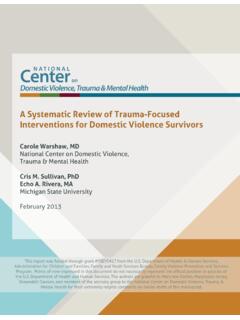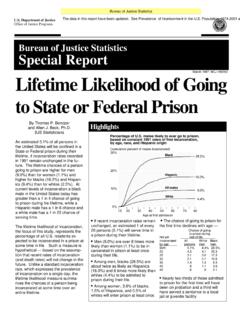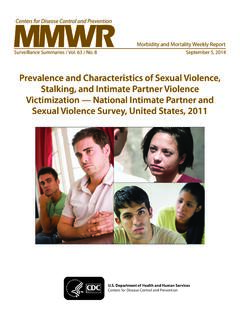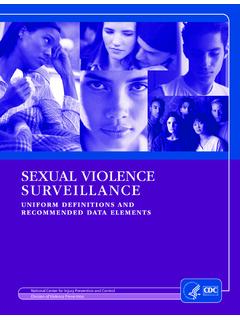Transcription of 7. What percentage of rape cases gets prosecuted? What are ...
1 Top ten things advocates need to know 1. What services do survivors of rape find most helpful, and what help do they say they need? 2. What type of sex offender is most likely to recommit their crimes? Incest offenders, rapists, or pedophiles? 3. What mental health issues are caused by experiencing intimate partner violence or sexual assault? 4. Do protective orders work? Who violates protective orders the most? 5. What is the impact of mandatory arrest laws on intimate partner violence victims and offenders? 6. What are the most significant long-term health consequences of chronic sexual or physical violence? 7. What percentage of rape cases gets prosecuted? What are the rates of conviction?
2 8. Does treatment with intimate partner violence offenders work? 9. Does a report of intimate partner violence or sexual assault by a partner put a woman at risk of losing custody of her children? 10. How do women from different racial/ethnic backgrounds experience intimate partner violence (IPV) or sexual assault? Does race and ethnicity matter? For more information on the Center for Research on Violence Against Women and to find PDFs of the Top Ten Things Advocates Need To Know Series, visit In 2010 the Center for Research on Violence Against Women conducted a survey with over 100 rape crisis and domestic violence advocates in Kentucky about what they needed to know from research to help them do their jobs.
3 Advocates identified ten top issues. A series of ten briefs were prepared by the Center to answer the Top Ten Things Advocates Need to Know. UK Center for Research on Violence Against Women A key mission of the Center for Research on Violence Against Women is to ensure that the findings of quality research make it into the hands of advocates. This translation of research to practice ensures that science has an impact on the lives of women and children. 1 | UK Center for Research on Violence Against Women | Research to Practice Brief | December 2011 Introduction The most recent national study examining the prevalence of rape in the United States was reported in 2007 and estimated that 18% of women in this country have been raped in their lifetime (1).
4 Based on their interviews with a representative sample of 5,000 women, the researchers in this study estimated that around 1 million women were raped in 2005, the year of the study. While that Rape in America report spotlighted the plight of 1 million women, however, official data from the Federal Bureau of Investigation indicate that only about 94,000 rapes were reported to law enforcement in the same year (2). Together, these data suggest that fewer than 10% of rapes that occur in the United States are ever reported to police. When sexual assaults are reported to law enforcement, very few cases end up being prosecuted, with research indicating that only 14-18% of all reported sexual assaults ultimately get prosecuted (3, 4, 5, 6).
5 When limited to rape only (rather than including all forms of sexual assault), prosecution rates are slightly higher. The National Violence Against Women Survey (7) estimated that 37% of reported rapes of adult women were prosecuted. Not all prosecuted cases end in a conviction. The NVAWS estimated that only 18% of rape cases involving adult women result in a conviction. Since most rapes are not reported to police, the study estimated that only of all rapes ultimately lead to a conviction for the offender. Several factors affect if and how a rape is reported and prosecuted, and whether or not the case results in a conviction.
6 This report reviews research on the prosecution of rape, and examines factors which appear to affect the likelihood of prosecution or conviction. QUESTION 7: What percentage of rape cases gets prosecuted? What are the rates of conviction? Report AT A GLANCE A national study estimates only 37% of reported rapes are prosecuted. 18% of prosecuted rape cases end in a conviction. Research suggests a survivor s decision to report a rape case and continue within the legal system is one of the most important factors affecting the prosecution of rape cases . The criminal justice system can often deter women from continuing their cases due to secondary victimization . Women may be retraumatized by having to repeatedly tell their story and detailed investigations by law enforcement may make survivors feels like they are not believed.
7 A Sexual Assault Nurse Examiner, Sexual Assault Response Team or other advocates may be effective in helping rape survivors understand the legal process without feeling further victimized by the process. Prosecutors often only take cases they can win, for rape cases many factors may be considered. Often cases are unwittingly approached with rape myths and stereotypes about race, class, gender and the deservingness of rape victims. Research shows that even when charges are filed, the legal system often downgrades or drops felony rape charges for guilty pleas on other crimes. This often does not feel like justice for survivors since the offender never has to admit or acknowledge that his actions were rape.
8 More effort is needed in understanding and eliminating the gap between the ideals of cultural and legal rape reforms, and the application of these ideals within the realities of the criminal justice system. In 2010 the Center for Research on Violence Against Women conducted a survey with over 100 rape crisis and domestic violence advocates in Kentucky about what they needed to know from research to help them do their jobs. Advocates identified ten top issues. This brief is one in a series of ten prepared by the Center to answer these top ten research questions. 2 | UK Center for Research on Violence Against Women | Research to Practice Brief | December 2011 Reported Rape cases in the Criminal Justice System The likelihood and outcome of rape case prosecution is dependent on a number of factors, as noted below: 1.
9 First, as mentioned above, most rapes are never reported to police. Research suggests, however, that the sooner a rape is reported, the more likely it will be prosecuted. When a rape is reported early, there is a greater likelihood that medical forensic evidence can be collected (5, 8), and that law enforcement, prosecutors, and jurors will find the survivor's story credible (9, 10). 2. Women raped by strangers on average report the incident much sooner than those raped by a known person, even though the typical rape perpetrator is likely to be an intimate partner or acquaintance (4, 7). Research suggests that cases are more likely to be reported and prosecuted if they involve strangers, multiple offenders, and other crimes which co-occur with the rape (12).
10 3. More severe cases are also more likely to be prosecuted (9). One study conducted 102 in-depth interviews with women in Chicago, and found that only 25% of reported rape cases were prosecuted (4). In this particular study, 70% of the prosecuted cases had white victims, and 80% of the prosecuted cases closely fit the profile of a "classic rape case" involving a stranger offender, injuries, and/or weapon use (4). Once a rape has been reported, the criminal justice process involves several gatekeeping steps from the initial report to prosecution. Much of the research on barriers to prosecuting rape cases focuses on two critical stages of the criminal justice system: the police investigation stage, and the prosecutor stage.







